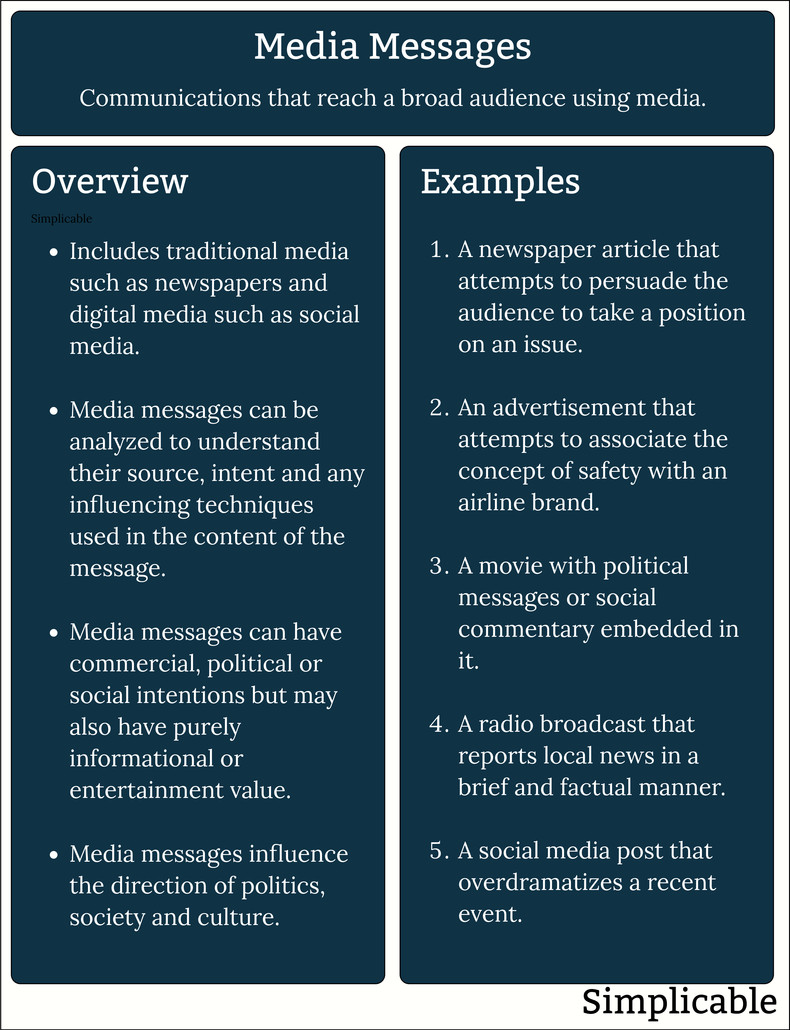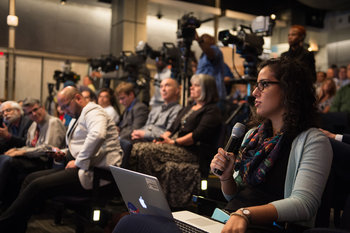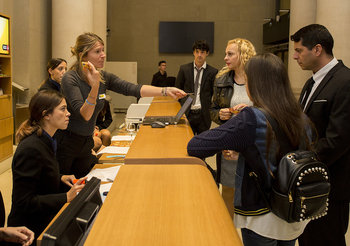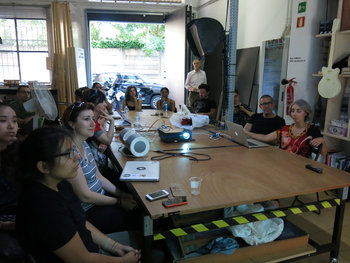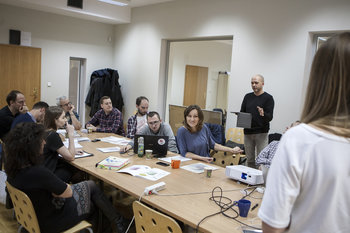|
| |
Media messages are communications that reach an audience. These can be deconstructed to determine their intention and technique. At the top level, media messages typically have commercial, political or social intentions behind them. These messages may employ a variety of influencing and political techniques such that their true nature and purpose isn't always immediately apparent. The following are illustrative examples of strategies, tactics and techniques commonly used in media messages.
Glittering GeneralityA glittering generality is a vague and emotional political statement that serves as a thought-terminating cliche. For example, "unite for [something good]."SignalingAttaching yourself to a trendy or popular cause in order to try to gain social status. For example, social issue themes in advertising designed to make a brand feel virtuous.
CountersignalingCountersignaling is the practice of trying to show strength by criticising yourself. For example, a capitalist corporation that calls for an end to capitalism. This is likely to be insincere but is an example of radical chic, whereby elites embrace radical ideologies because they feel thrilling without any real support for the cause.Useful Idiot StrategyUseful idiot is the practice of convincing people to support something that they probably wouldn't support if they fully considered the issue. This typically uses bait and switch where a popular glittering generality is used to sell something that wouldn't be popular with a more in-depth look.Divide and ConquerSowing discord to prevent people from unifying in their best interests. For example, using aspects of identity to prevent class consciousness of the working class and middle class from challenging the upper class.False DichotomyA false dichotomy or false dilemma is the presentation of an issue as a set of two choices when in fact other options exist. For example, "either you agree with this policy or you are against science."Fear, Uncertainty and DoubtThe practice of pushing a supposedly safe option by creating fear, uncertainty and doubt around other options. For example, large technology firms that suggest that the products of smaller firms are risky. For example, the informal slogan "nobody ever got fired for hiring [big firm]" that implies hiring the competition might get you fired.SensationalismAppeals to drama such as exciting or disturbing stories.ClickbaitClickbait is a sensationalized or otherwise inaccurate title or heading that is designed to attract an audience.InnuendoHinting at something that would be inappropriate to say. Appeal to AuthorityAn appeal to authority, or ethos, is a claim that something is associated with an authority such as an institution or profession. For example, a consultant who claims to have high status firms as customers.Weasel WordsWeasel words are phrases that are designed to sound like an authoritative source when in fact you have no source. For example, phrases such as "the science says ..." that isn't backed up with any actual reference to any studies.Appeal to LogicAn appeal to logic, or logos, is a rational argument such as a politician who gives a seemingly reasonable reason for a policy.Appeal to EmotionAn appeal to emotion, or pathos, tries to trigger emotions in an audience such as fear, dislike or compassion.Social StatusAppeals to social status such as wealth, intelligence, coolness and youthfulness. For example, a soft drink commercial that tries to associate a brand with trendy youth culture.CelebritiesCelebrities are used in media messages as personifications of social status. For example, a celebrity that symbolizes social connectedness and wealth to a large audience.HumorHumor is another mode of influencing that can be used to build goodwill with an audience.StorytellingStorytelling is the art of conveying meaning in an entertaining way. NudgesA nudge is the practice of conveying subtle messages over commands. In many cases, this has far more influence. For example, a commercial for a nonprofit that asks a question as opposed to commanding you to make a donation.Call to ActionA call to action is a direct command to do something such as "buy now!" Many people will find this harsh and overassertive. However, others may be responsive to such commands as they are known to work to improve conversion rates and close sales. Brand RecognitionPeople are more likely to purchase brands they recognize such that the purpose of advertising is often to build recognition of brand name and visual symbols such as logos and trade dress. Brand AwarenessBeyond recognition, brands may try to get customers to recognize attributes of a brand. For example, a car company that tries to establish an image of safety.Misinformation & DisinformationMisinformation is the process of lazily distributing untrue information because it aligns to your intentions or views. Disinformation is the process of purposely crafting and distributing information you know to be wrong.False FlagPretending to represent one side in order to make that side look bad. For example, pretending to belong to a political movement and then making absurd and excessive statements.Peak-end RuleThe principle that people will only remember the start and end of a relatively long communication such as a speech of more than 60 seconds. In the analysis of media messages, special attention is paid to the start and end of communications.PropagandaPropaganda is political messaging, particularly that which originates with large organizations such as governments. Governments have deep resources such that propaganda efforts can begin to feel oppressive with messages that are overcommunicated ad nauseam.AstroturfingAstroturfing is the practice of pretending that a message that originates with a government, large organization or industry stems from community effort.NoiseMedia messages aren't necessarily purposeful and strategic, they can be more or less random such as a statement that someone happens to make in a moment without giving it much thought.OverviewMedia messages can have commercial, political or social intentions behind them and commonly use influencing techniques. It is also possible for the media to be purely informative or entertaining.NotesPostmodern media theory is centered around the idea that media messages are "constructed." This simply means that they are composed with a purpose -- often using an influencing technique such as those listed above.Deconstruction is a post-modern term for analysis whereby to understand something you break it down and try to understand its component parts. This term is overused as recognizing the techniques employed by a message is more of an interpretation or critique.Next: Media Analysis
More about media messages:
If you enjoyed this page, please consider bookmarking Simplicable.
© 2010-2023 Simplicable. All Rights Reserved. Reproduction of materials found on this site, in any form, without explicit permission is prohibited.
View credits & copyrights or citation information for this page.
|

